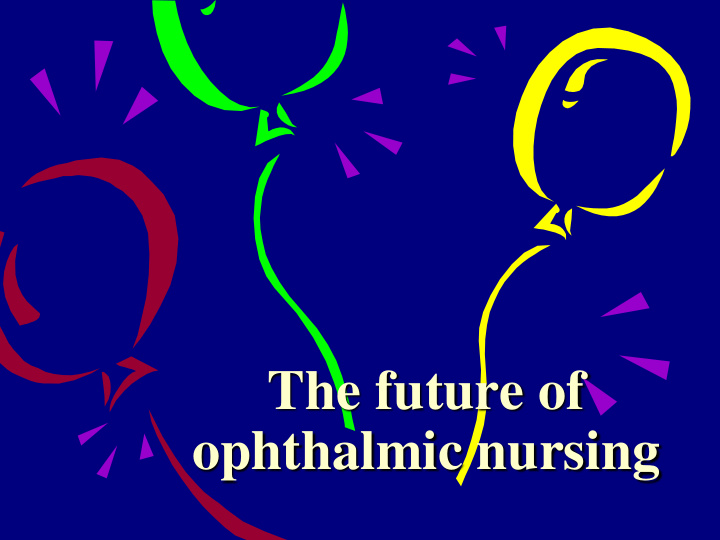



The future of ophthalmic nursing
Where did we come from? • the big eye hospitals were set up around 200 years ago in response to obvious local need and a series of foreign wars, bringing in eye disease • some sort of nursing, but untrained and working under the orders of a doctor • ophthalmic nursing texts – 1894 for those working with children in the ‘ ophthalmic schools ’ • pre and post registration ophthalmic training OND ONC • ENB, SNB, WNB • universities, the rise of general management • education almost disappears
Stephenson S (1894) Ophthalmic Nursing - For the Ophthalmic School, Hanwell – a workhouse residential school for children with ‘ ophthalmia ’ , one of a number Chapters on • ‘ the Germ theory of disease ’ • Structure and action of the eye • Contagion and infection • purulent ophthalmic – gonococcal, resulting often in blindness in one or both eyes • mucopurulent – bacilli found, no ophthalmic sequelae, gets better • Trachoma - blinding
Treatments • Counter irritants (cause severe inflammation at some distance from the affected part) A fly blister the size of a shilling or half a crown on the temple of behind the ear, a blister plaster or blistering fluid, then prick the blister. Either dress with soothing ointment, or if necessary, stop from healing • Blood letting – used to be used as the sovereign remedy for acute Ophthalmia but nowadays (!)…scarifying the conjunctiva, opening an artery in the temple or (and the nurse may do this) applying a leech to he temple, forehead or behind the ear
Nursing � Care • In the serious inflammatory disease of the eye and after operations the nurse should talk to the patient only in the course of her duty demands and allow the patient to talk but very little. Only recently, a lady under my care with chronic inflammatory glaucoma was thrown into an acute attack lasting for a period of twenty-four hours because the nurse allowed a friend of the patient to sit and talk to her for two hours. • Sleep is essential to the healing process, If there is much pain an opiate must be given. Increase the intervals between times for cleansing during the night because, if the patient is kept awake continuously for 2-3 days, the general strength is reduced and the vitality is so lowered that evil consequences result from a lack of general nutrition and rest as well as from the local disease
Whiting M (1941) Ophthalmic nursing 3 rd edition (Moorfields) Preface - The introduction of sulphonamide and kindred drugs in the treatment of bacterial infections is perhaps the most important single medical advance of the last 4 or 5 years
Nursing Care • Absorptive treatment. Administration by mouth of potassium iodide in conjunction with mercury ointment *rubbed in daily, a different site for rubbing is used each day (inner thigh, inner arm) and hot air baths preceded by an injection of pilocarpine to induce sweating. Uses in cases where the absorption of inflammatory exudates is desired. • Cataract extraction – soft diet, both eyes bandaged for 3-4 days, off absolute bed rest at the end of a week (it happens rarely that cataract patients develop mental symptoms shortly after operation. Due partly to age, partly to closing both yes and sometimes to the toxic effects of atropine. Take the pad of the unoperated eye, stop atropine and give hypnotics). Home after 14 days
Garland P (1962) Ophthalmic Nursing 4th edition • Admitted 2 days pre op, phenobarbitone, bath and hair wash, practice using a bed pan and drinking from a feeder • Move the locker to the side of the unaffected eye • Both eyes bandaged for 24-48 hours • Speak to patient from side of unoperated eye • If feeding him, the patient may hold the feeder but the nurse must keep her hand on it. • At night, hands tied with flannel bandage, sedative • 9 th – 12 th day, patient discharge (the recent tendency is for very early discharge)
Where are we now? All ophthalmic nurses do is put eye drops in… One of the first nursing specialties to undertake advanced practice roles…and one of the first to reclaim and develop them
Continuum of Clinical Nursing Practice From very traditional roles as doctor ’ s helper….. To much more autonomous roles
United Kingdom Roles • Cataract care • Accident and emergency services • Anaesthetic support • Medical specialities • Oculoplastics • Vitreo-retinal • Glaucoma • Cornea • Uveitis • Diabetes • ROP
Where do WE go from here? Happening now… • • UK - intravitreal injections (nurses and…others) and the next thing? • NZ - government proposal for nurse cataract extraction
We do some amazing and innovative things • We change roles to fill service gaps • We look after the whole age range • We look after the whole range of acuity from urgent to continuing care and rehab • We are very good at what we do • We make a difference • We could make a bigger one!
We do some amazing and innovative things • But - if we are to continue to do so, we need to get the basics right… • Education and training • Knowledge base • De-skilling - nurses, doctors • Titles • Career Progression • Succession management • Pay – grades…disparity
The future of ophthalmic nursing …is the future of all specialist nursing in the UK • Massive issues…and more to come • Vital for the future of health care
Thankyou for listening
Recommend
More recommend